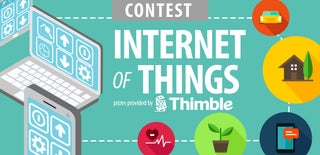Introduction: Control Home Appliances With Phone and Internet of Things Under 6 $
I always wanted to turn on my Tv while laying on my couch, Or after a tiresome day when i finish reading a book , to turn off my Light.
I did this before with a Hc-05, and tv remote .
https://www.instructables.com/id/How-to-make-a-Chea...
Update : This Entry is accepted for IOT Challenge so if you like the project do give ur vote .
what is home automation ?
Home automation is the use and control of home appliances remotely or automatically.
What is IOT ?
The Internet of Things (IoT) is the network of physical objects—devices, vehicles, buildings and other items—embedded with electronics, software, sensors, and network connectivity that enables these objects to collect and exchange data.
Combine this Both You can control your home appliances from anywhere where we can access Internet.
It is totally based on the cloud services offered by Blynk
Step 1: Ingredients
6$ would not be possible if esp8266 was not used In the Stand Alone Mode
Here is the list of items we need for making the IOT Home Automation Box
- Esp8266 esp 1 3$
- Ams1117 0.09$
- 2 Channel Relays 1.5 $
- Enclosure Box (bought it locally for 20 rupees ) 0.3$
- Charger 1.3 $
Total 6.1$
So its all around 6$
Indians can buy it from here
We would also need tool
- File
- Wire Cutter
- Wire
- FTDI chip /Arduino
- Perf Board
- Soldering Iron
- Solder
Step 2: Programming the Esp8266
The First task is to set up the ESP for the programming .
It had two modes of operation
Normal Mode For GPIO 0 =1;
Program Mode For GPIO =0;
So we right now need to put it in programming mode.
The Connection will be as follow
- Vcc And CH_PD to 3.3 v
- Gnd of Esp to Gnd
- Rx of Esp to Tx of Arduino
- TX of Esp to Rx of Arduino
- GPIO 0 to Gnd
Once a program is being uploaded we need to pull down reset to ground once and the , the programming mode is enabled.
Detail instruction are given in this instructables
Step 3: Connecting to Blynk Server
Connecting to The Blynk is a easy task though
First we need to download the blynk app
IOS
https://itunes.apple.com/us/app/blynk-control-ardu...
Android
https://play.google.com/store/apps/details?id=cc.b...
Open the app and create a new project.
The Project device should be selected as ESP8266.
After its done you will get a authorization token .
you need to enter the token in the sketch attached.
Now we Create Button from the widget bar.
The Button is then clicked to select the GPIO it will work on.
We choose the button to be a switch.
you can aslo rename the button as Bulb /Fan Etc.
Here is the library
Step 4: Making the Board for the Esp 8266
So here is the hard part and the most time consuming part.
We first cut a perf board so that it fits the enclosure.
we start to solder the the 3.3V ams1117 first.
Then we solder the Headers for the ESP8266.
We make the connection as per diagram.
I have used a screw terminal in my case to unplug the sytem as i m using a charger to power the board.
I first used a 350 ma plug which didn't work too well then i upgraded to 700ma which is decent for the system.
The relays need to be connected to 5v .
I also added a switch and led for indication (optional part)
Step 5: Creating the Enclosure
I took a 4 x4 x2 box . I started to drill a hole at the connect for the power cord to enter through this i then used a silicon carbide grinding bit to smoothen the hole .
I also drilled two on the two and four on the side for the relays.
The top one was for the switch and the led.
I glued the led and switch to the case .
Basically the switch is for turning the relay on after the esp 8266 has safely booted.
Two wires are soldered to the switch for connection which we will later solder to the board.
Step 6: Putting Everything Inside
Now its time to assemble all the parts.
we first take the main board and put it inside the box .
Then we attach the esp 8266 to the header.
Then we connect the switch to vcc and the relay header.
The relay was connected to the header with female to male fire.
After everything was in its place we assemble the case and power it on to enjoy the Light controlled by wifi and IOT.
If you liked the project do like my page to get updates on future Projects

Participated in the
Internet of Things Contest 2016

Participated in the
Home Hacks Challenge














